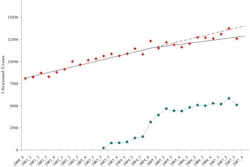The American College of Radiology (ACR) of Reston, VA, has published a new set of Appropriateness Criteria to guide radiologists in making diagnostic imaging and treatment decisions about children to identify developmental dysplasia of the hip.
The recommendations were developed by a team of radiologists and pediatric specialists, including representatives from the American Academy of Pediatrics, the American Pediatric Surgical Association, and the Office of Pediatric Therapeutics of the Food and Drug Administration. They were published in the August issue of the Journal of the American College of Radiology (2009, Vol. 6:8, pp. 551-557).
Developmental dysplasia of the hip comprises abnormalities that include abnormal acetabular shape and malposition of the femoral head, ranging from dislocatable hip and mild subluxation to fixed dislocation. It affects approximately 1.5 infants out of 1,000 and is a condition that occurs four to eight times more frequently in girls.
Some 60% to 80% of abnormalities identified by physical examination and more than 90% identified on ultrasound resolve spontaneously. However, because untreated subluxed and dislocated hips can lead to impaired function, it is important to identify this condition in infancy.
Infants should be clinically evaluated for hip dysplasia by pediatricians during routine well-infant examinations at 1 and 2 weeks of age, and at 2, 4, 6, 9, and 12 months of age.
An ultrasound examination should be performed for all infants identified at risk older than 2 weeks of age. Selective ultrasound screenings can identify the condition in children at high risk but with negative physical examination findings. Risk factors are identified as clinical instability, breech presentation, postural foot deformities, and family histories of hip dysplasia.
The criteria follow guidelines from the American Academy of Pediatrics of Elk Grove, IL, which recommend selective use of ultrasound for infants younger than 4 months of age, according to Dr. Boaz Karmazyn, director of pediatric radiology at Riley Hospital for Children in Indianapolis, who headed the criteria development team.
The team recommends that an x-ray is clinically appropriate only after an infant is 4 months or older.
Related Reading
US screening advised for newborns at risk for hip dysplasia, July 2, 2009
Early ultrasound may help prevent surgery for hip dysplasia, December 5, 2003
Copyright © 2009 AuntMinnie.com



















